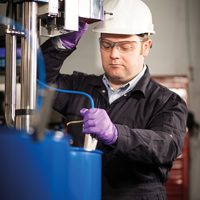 Safeguarding Against the Hazards of Static Electricity
Safeguarding Against the Hazards of Static ElectricityFor any person responsible for the safety of employees, colleagues, plant equipment and plant property, one of the most potentially confusing aspects of providing a safe operating environment is trying to determine if that site’s manufacturing or handling processes have the potential to discharge static sparks into flammable or combustible atmospheres.
Because static ignition hazards occur at the “nuclear level”, it is naturally difficult to visualise how and why static electricity is a hazard in industries where flammable and combustible products are regularly processed. There are so many variables that have a role to play, it is almost impossible to predict the net effects of these parameters, in a hazardous prevention context, without feeling the need to conduct controlled laboratory testing to determine if a specific process could produce incendive electrostatic discharges.
If you consider that walking across a carpet can generate 35,000 volts (35 KV) on a person, it is easy to see how normal everyday processes can generate potentials well in excess of 10,000 volts (10 KV). For a small object like a metal bucket, which has a typical capacitance of 20 pico-farads, the total energy available for discharge at 10 KV is 1mJ. This is higher than most flammable vapour Minimum Ignition Energies (MIE’s). In powder conveying operations voltages of the order of 1000 KV can easily be generated on parts of the conveying system. Road tankers undergoing loading can carry as much as 2000 mJ of ignition energy.
Which standards should I follow to control static electricity in ignitable atmospheres?
Fortunately, there are several internationally recognised standards that provide guidance on ways to limit electrostatic hazards enabling those responsible for worker health and safety minimise the risk of incendive static discharges.
Hazardous area operators who can demonstrate compliance with these standards will go a long way to providing a safe working environment and preventing the ignition of ignitable atmospheres. The most comprehensive standards are:
NFPA 77: Recommended Practice on Static Electricity (2007).
CENELEC CLC/TR 60079-32-1: “Explosive atmospheres - Part 32-1: Electrostatic hazards, guidance” (2015).
API RP 2003: Protection against Ignitions Arising out of Static, Lightning and Stray Currents (2008).
API RP 2219: Safe Operation of Vacuum Trucks in Petroleum Service (2005).
The standards, particularly NFPA 77 and CLC/TR: 60079-32-1, describe a range of processes where static charges can be generated including flow in pipes and hoses; loading & unloading of road tankers; railcar loading & unloading; filling and dispensing portable tanks, drums and containers; storage tank filling and cleaning; mixing, blending and agitation operations; the conveying of powders and other operations.
The API RP 2003 standard focuses on road tanker loading and railcar filling operations, storage tank filling and general operations involving petroleum products. API RP 2219 provides detailed guidance on protecting vacuum trucks from electrostatic hazards.
The earth has an infinite capacity to absorb charges and “earthing” (grounding) is the act of connecting a body to an electrode (or other buried structure) that has a verified contact resistance to the ground, typically less than 25 ohms.
Earthing provides a path for static charges to rapidly flow to earth, reducing the voltage of the object to zero and thereby eliminating the presence of an ignition source. “Bonding” connects objects so that they are at the same electrical potential preventing discharges when they are positioned in close proximity to each other. If bonding is carried out, it is important to ensure that one of the bonded objects is connected to earth, thereby ensuring all parts of the bonded system are at zero potential.
Newson Gale’s Earth-Rite®, Bond-Rite® and Cen-StatTM static safety solutions can provide you with the necessary monitoring and control to protect your people, plant and processes.
For more information visit:
www.newson-gale.co.uk



